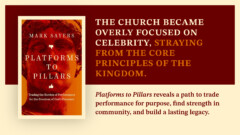Paul Jones, organist and Music Director at Tenth Presbyterian Church in Philadelphia is, by all accounts, a very talented individual. He was privileged to serve alongside James Boice (who once said “Paul is everything I ever prayed for in a music director”) and now works closely with Philip Ryken in serving one of America’s foremost Presbyterian churches. Singing and Making Music, subtitled “Issues in Church Music Today” is Jones’ attempt to distill and share some of his years of accumulated wisdom and knowledge.
Singing and Making Music is not a traditional book, emphasizing an argument that moves logically from introduction to conclusion, but is a collection of essays dealing with the common theme of worshipping God through music. To some extent this leaves the book feeling a little bit disjointed and without a consistent flow. At the same time, this format allows the author to cover a wide range of topics without having to bridge one to another. I feel that this is a suitable format for such a book book. Jones covers a great deal of ground through the book’s thirty-three chapters which are grouped under four headings: Corporate Worship, Hymnody and Psalmody, Issues and Composers and Composition. Here is a selection of chapter titles:
- Sermon in Song: Sacred Music as Proclamation
- Sacred Music as Prayer
- Authenticity in Corporate Worship Music
- Trinitarian Hymnody
- What Psalm Ascriptions Tell Us
- Writing Hymns
- Choir for Hire: Should Church Musicians Be Paid?
- Luther and Bar Song: The Truth, Please!
- Musical Ignorance versus Music Arrogance
- J.S. Bach and Musical Hermeneutics
- The Anatomy of a Hymn Tune
- Criteria for Good Church Music
While any Christian could benefit from reading this book, the target audience is clearly intended to be other music directors or worship leaders. With my limited knowledge of musical theory, I was occasionally unable to follow or understand the author’s arguments. This was particularly true of the chapters which discussed topics which are far more theoretical than practical to me, such as “The Anatomy of a Hymn Tune,” a chapter in which we read the following: “Such intervallic relationships between voices other than the melodic one (i.e., the altor, tenor, and bass) have to do with harmonic choices. The harmony throughout the hymn tune is functional, yet colorful, with numerous intentional dissonances.” For all I know, he may have just insulted my country or provided a recipe for chocolate brownies (though I suspect not).
Thankfully, the majority of the book is perfectly accessible to a person like myself who loves music, but knows very little about it. Jones is always gracious but always biblical when dealing with some of the more contentious issues facing churches struggling with the subjects of worship and music. He argues that Christians ought to avoid the world’s musical trends and to develop music that is distinct. The book’s main points can be summarized under the three following headings. First, worship practices must be measured by the Word of God. “Scriptural principles should inform all our thinking, traditions, and practices in worship.” Second, we need to comprehend the pastoral nature of music ministry. “Music is not in competition with pastoral work. It is pastoral work in the sense that it can provide many of the same kinds of spiritual care and leadership that pastoral ministry provides.” Third, we should ensure that budgets and practices are informed by these truths. “Music in worship cannot be truly conformed to biblical standards and examples of excellence unless it is actively supported by the church leadership in word and deed and is adequately funded.” You can see a logical progression from theory to practice. A church should move from asking “Why do we do what we do in the way that we do it? How should we be doing it according to Scripture? What will it take to make it so?”
While Jones serves in a large church and surely enjoys a large budget, he is sensitive to those who serve in smaller churches and may have only a limited number of resources, both financial and human, to dedicate to music. He provides suggestions on the first instruments a church should purchase and the type of music director a church should eventually seek. He suggests when a church should seek to hire a music director and what type of responsibilities he should enjoy. There is even a chapter providing instruction on purchasing an organ.
Always practical and biblical, Singing and Making Music was an enjoyable read and one that is suitable for both the laity and those in leadership. Ligon Duncan, in his endorsement for this book, described it with the phrase “constructively provocative.” I believe that is an apt description. This book is deeply biblical, uplifting and constructively provocative. It is well worth reading.










